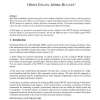Free Online Productivity Tools
i2Speak
i2Symbol
i2OCR
iTex2Img
iWeb2Print
iWeb2Shot
i2Type
iPdf2Split
iPdf2Merge
i2Bopomofo
i2Arabic
i2Style
i2Image
i2PDF
iLatex2Rtf
Sci2ools
WCET
2008
2008
Applying WCET Analysis at Architectural Level
Real-Time embedded systems must enforce strict timing constraints. In this context, achieving precise Worst Case Execution Time is a prerequisite to apply scheduling analysis and verify system viability. WCET analysis is usually a complex and time-consuming activity. It becomes increasingly complex when one also considers code generation strategies from high-level models. In this paper, we present an experiment made on the coupling of the WCET analysis tool Bound-T and our AADL to code generator OCARINA. We list the different steps to successfully apply WCET analysis directly from model, to limit user intervention.
| Added | 30 Oct 2010 |
| Updated | 30 Oct 2010 |
| Type | Conference |
| Year | 2008 |
| Where | WCET |
| Authors | Olivier Gilles, Jérôme Hugues |
Comments (0)

